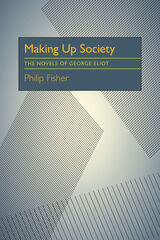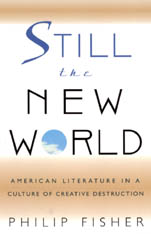

Fisher places the work of George Eliot within the great evolution that constitutes the nineteenth-century English novel. He reports not only about her work, but about an evolving complex literary form. Fisher examines Eliot’s work as responding to “the loss of society,” the breakdown between public life and individua moral history. As trust in the community as a base of moral life weakens, decisive changes occur: the English novel accommodated itself to the disappearance of society and changed from the representation of individuals as members of a social order to the description of the self surrounded by collections of unrelated others.

In this bold reinterpretation of American culture, Philip Fisher describes generational life as a series of renewed acts of immigration into a new world. Along with the actual flood of immigrants, technological change brings about an immigration of objects and systems, ways of life and techniques for the distribution of ideas.
A provocative new way of accounting for the spirit of literary tradition, Still the New World makes a persuasive argument against the reduction of literature to identity questions of race, gender, and ethnicity. Ranging from roughly 1850 to 1940, when, Fisher argues, the American cultural and economic system was set in place, the book reconsiders key works in the American canon--from Emerson, Whitman, and Melville, to Twain, James, Howells, Dos Passos, and Nathanael West, with insights into such artists as Winslow Homer and Thomas Eakins. With striking clarity, Fisher shows how these artists created and recreated a democratic poetics marked by a rivalry between abstraction, regionalism, and varieties of realism--and in doing so, defined American culture as an ongoing process of creative destruction.

Why pause and study this particular painting among so many others ranged on a gallery wall? Wonder, which Descartes called the first of the passions, is at play; it couples surprise with a wish to know more, the pleasurable promise that what is novel or rare may become familiar. This is a book about the aesthetics of wonder, about wonder as it figures in our relation to the visual world and to rare or new experiences.
In three instructive instances--a pair of paintings by Cy Twombly, the famous problem of doubling the area of a square, and the history of attempts to explain rainbows--Philip Fisher examines the experience of wonder as it draws together pleasure, thinking, and the aesthetic features of thought. Through these examples he places wonder in relation to the ordinary and the everyday as well as to its opposite, fear. The remarkable story of how rainbows came to be explained, fraught with errors, half-knowledge, and incomplete understanding, suggests that certain knowledge cannot be what we expect when wonder engages us. Instead, Fisher argues, a detailed familiarity, similar to knowing our way around a building or a painting, is the ultimate meeting point for aesthetic and scientific encounters with novelty, rare experiences, and the genuinely new.
READERS
Browse our collection.
PUBLISHERS
See BiblioVault's publisher services.
STUDENT SERVICES
Files for college accessibility offices.
UChicago Accessibility Resources
home | accessibility | search | about | contact us
BiblioVault ® 2001 - 2024
The University of Chicago Press









